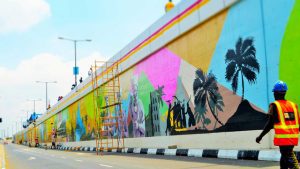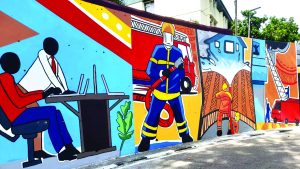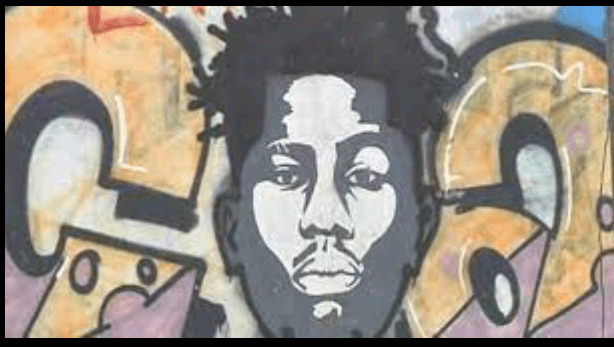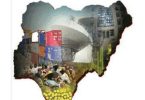Art in all possible forms, has always been a vibrant aspect of Nigeria’s multifaceted and diverse cultural identity. Whether it is music, dance, drawing, painting, acting, poetry, tattooing, fashion, clothing material, hair styling, storytelling, or writing. Nigerian people proudly express themselves and celebrate their many distinct cultural identities through art. And now they have chosen to perfect and promote their many creative expressions of art on the global scene, and with resounding success. However, a critical stage of birth, experimentation, and creative expression is often found in Nigerian street art.
Great artistic talents are often discovered and nurtured on the very streets of Nigeria. Lagos is a clear example – a hotbed of emerging of artistic creativity. You will find vivid examples of creative experimentation of art in public spaces across Lagos, and places like Benin city. On public walls, sculpture, doors, posters, tarred and cemented grounds, bridges, and even on vehicle bodies. It’s a crazy yet exhilarating spectacle of bold, defiant scrawls and colourful, and paintings that speak volumes.
Where Did Nigerian Street Art Emerge From?
Art has for long been created beyond the confines of history museums and art galleries. It started on ancient cave walls, on trees, and on animal skins. And it made its way to dwelling places – be it residential wall and floor paintings, framed paintings, craftwork, and sculptures. We cannot ignore that Nigerians (and Africans) have also perfected body art for centuries – in the form of tattoos, hairstyles, tribal marks, and cultural costumes.
To say Nigerian street art is a product of Western influences (through the mass media) and modern education is far from being accurate. Art is engrained in every aspect of Nigeria’s multifaceted culture, as we have already stated.
Street murals, carvings, and sculpture, take deep inspiration from the traditional motifs, symbols, and patterns used to decorate walls of traditional structures. Namely traditional shrines, kings’ palaces, residences of titled chiefs and influential people, and communal meeting places. A glance at pictures of the Osun Osogbo shrine; and palace walls of traditional rulers across Nigeria will testify to this. Furthermore, Nigeria’s political history, and the socio-economic struggles and experiences of the everyday Nigerian speak loudly in Nigerian street art.


Although it probably emerged earlier in time, Nigerian street art became very prominent sometime in the 1980s. And it is nowhere so fervently promoted, compared to the city of Lagos. A walk through famous street art hotspots (like Agege, Ojuelegba, Oshodi, FESTAC, Ikeja, Surulere and more) will be more than rewarding. One will find curious and thought-provoking scrawls, graffiti, paintings, drawings, cement/metal/wood sculptures, stencil, and other craftwork on walls, bridges, grounds, vehicles, posters, everywhere. Some of the notable Nigerian street art exponents include Yusuf Grillo and Osa Seven.
Thus, practitioners of Nigerian street art deftly combine traditional design (and performance) ideas with modern ones. Then they proceed to use public spaces to showcase their skills. They often meet, interact, collaborate, add to existing work, or create fresh design ideas. And they continue to evolve, creating exciting new art forms.
A Commentary on Nigerian Street Art
Nigerian street art – particularly mural designs – is a vibrant display of bold themes, symbolism, multiple colours, and messages with deep meanings. Overall, Nigerian street art has become a medium of social commentary and narratives, alongside creative expression all at once. It defiantly pushes back at social barriers and established norms. The artists are determined to express their creativity and innermost thoughts at every opportunity. They express their yearnings for a better society, criticize undesirable social issues, and reveal their opinions on key social topics. And all the while using every available surface and spot in public spaces.


Furthermore, big corporations and government entities have recognized the powerful ability of street art to communicate with everyday people. Now they recruit talented street artists to create appealing street art. These art forms serve a number of uses. Either to deliver important messages, celebrate key historical events and figures, act as important landmarks, or for advertising.
Popular Street Arts in Nigeria;
- The murals displayed on bridge props in Agege, Ikeja, CMS, and many other places in Lagos.
- Designs on the walls of Teslim Balogun stadium in Surulere-Lagos (amongst other stadia).
- The EKOTAG mural created by Osa Seven (to commemorate the 50th anniversary of Eko/Lagos) in Victoria Island.
- The ENDSARS mural drawn by Amaremo Elaebi, and Civilizedvillagrr in FESTAC area. It is a memorial of the anti-police brutality protests that took place in Lekki and Abuja in the year 2020.
- Paintings and sculptures symbolising the spirit of Lagos, located in several public places. Benin city, and some other popular urban centres in Nigeria also showcase them.
- Several learning institutions in Nigeria, from primary through secondary to higher institutions, also showcase street art. It is quite often done by their students; but not always the case. Such sculptures, murals, and craftwork are found on walls, in parks, and in prominent locations.
- Street music is hugely popular in Lagos (and some other cities). It has also led to the celebration of annual street and beach carnivals. They have become an arena from which a good number of Nigerian music artists have emerged. Music genres that are common with street music include reggae, gospel, and afrobeats.








